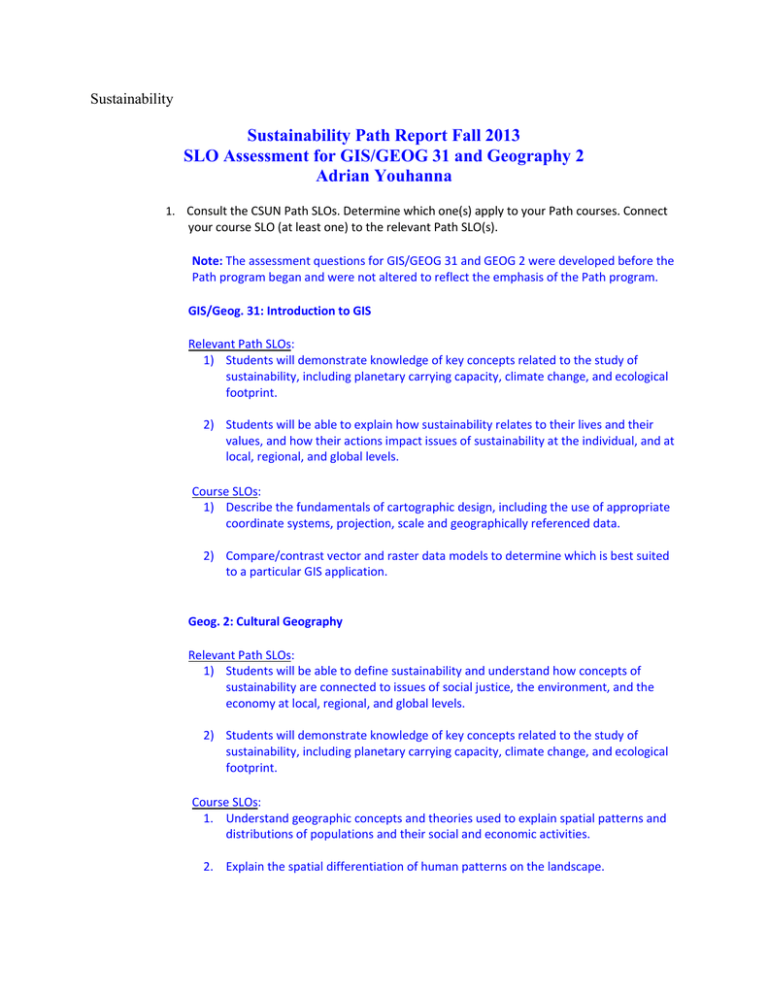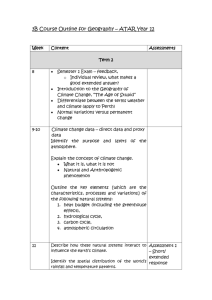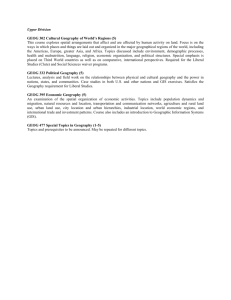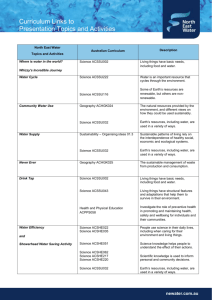Sustainability Fall13
advertisement

Sustainability Sustainability Path Report Fall 2013 SLO Assessment for GIS/GEOG 31 and Geography 2 Adrian Youhanna 1. Consult the CSUN Path SLOs. Determine which one(s) apply to your Path courses. Connect your course SLO (at least one) to the relevant Path SLO(s). Note: The assessment questions for GIS/GEOG 31 and GEOG 2 were developed before the Path program began and were not altered to reflect the emphasis of the Path program. GIS/Geog. 31: Introduction to GIS Relevant Path SLOs: 1) Students will demonstrate knowledge of key concepts related to the study of sustainability, including planetary carrying capacity, climate change, and ecological footprint. 2) Students will be able to explain how sustainability relates to their lives and their values, and how their actions impact issues of sustainability at the individual, and at local, regional, and global levels. Course SLOs: 1) Describe the fundamentals of cartographic design, including the use of appropriate coordinate systems, projection, scale and geographically referenced data. 2) Compare/contrast vector and raster data models to determine which is best suited to a particular GIS application. Geog. 2: Cultural Geography Relevant Path SLOs: 1) Students will be able to define sustainability and understand how concepts of sustainability are connected to issues of social justice, the environment, and the economy at local, regional, and global levels. 2) Students will demonstrate knowledge of key concepts related to the study of sustainability, including planetary carrying capacity, climate change, and ecological footprint. Course SLOs: 1. Understand geographic concepts and theories used to explain spatial patterns and distributions of populations and their social and economic activities. 2. Explain the spatial differentiation of human patterns on the landscape. 2. A brief report on your assessment results ("Tell the story") which answers the following questions: 1. How were students assessed? GIS/Geog. 31: Introduction to GIS GIS 31/Geography 31 students completed a final examination, in which questions related to key GIS concepts and principles were embedded. The SLO assessment method used for this course was a multiple choice exam. This course will be archived after Spring 2014. A new course has been developed to combine and replace GIS/Geog 31 (lecture) and GIS 32/Geog (lab). The SLO assessment method for the new course, GIS 25/Geog 25, will be a project. Geog. 2: Cultural Geography Geography 2 students completed a final examination, in which questions related to key cultural geography concepts and principles were embedded. The SLO assessment method used for this course was a multiple choice exam. 2. How were assessments used? In other words, how does your assessment reflect that your course maps to one or more CSUN Path SLOs? 3. How have you emphasized the Path theme in your course? GIS/Geog. 31: Introduction to GIS Many students are unfamiliar with Geographic Information System (GIS). GIS technology combines layers of data in a computer, creating maps in which patterns and processes are superimposed. With an ability to combine a variety of datasets in an infinite number of ways, GIS is a useful tool for nearly every field of knowledge from archaeology to zoology. In my course, I talk about how GIS enables community planners, economists, agronomists, and farmers to research and devise practices that will enable the sustainability of food production to ensure the survival of the human race. For example, GIS has the capabilities to collect, manage, analyze, report, and share vast amounts of agricultural data to aid in discovering and establishing sustainable agriculture practices. Geog. 2: Cultural Geography The concept of sustainability is vital to human geography. I talk about sustainability as it relates to 1) overpopulation and food supply (sustainable agriculture, manufacturing and service industries), 2) cities as the centers for economic and cultural activities, 3) Earth’s natural resources (cultural problems resulting from depletion, destruction and inefficient use of natural resources - deforestation). 4. Based on your experience and professional judgment, how well do think your students know the purported significance of a thematic GE program? In other words, do they make thematic connections between your course and other courses (in or outside the Path) in the GE program? The concept of sustainability is woven throughout cultural (human) geography. Geographers deal with a wide range of topics, from spatial patterns of human occupancy to the interaction between people and their environments. Because geography is highly interdisciplinary, I believe that students can make the thematic connections between geography and other disciplines such as anthropology and sociology. GIS provides the toolsets and framework for organizing multi-disciplinary information at all scales. Because of the interdisciplinary nature of GIS, students can apply their GIS skills to address issues of sustainability in the social sciences, environmental sciences, and economics. GE Sustainability Path SLO Assessment for Anthropology 101 for Bruce M. Rowe’s Anthropology 101 class section 150 Fall 2013. 1. The assessment questions for Anthropology 101 were developed before the Path program began and were not altered to reflect the emphasis of the Path program. 1 2 Assessment Questions For Anthropology 101 are as follows: You must display your answers on the back of the scantron form exactly as shown to get any credit for your answers: 1 101. A main area of study for physical anthropologists is the study of evolution. A. true B. False 2 2 2 102. Science can provide answers to all possible questions. A. true B. False 3 2 3 4 103. A theory is more certain than a guess but less certain than a fact. A. true B. False 5 2 5 104. The idea that humans are superior to other animals is termed anthropocentrism. A. true B. False 6 2 6 105. Charles Darwin was the first person to recognize that nature could be dynamic. A. true B. False 106. Darwin's theory states that groups who are better suited to their environment will be more likely to survive and reproduce. A. true B. False CSUN Path SLO: Students will demonstrate knowledge of key concepts related to the study of sustainability, including planetary carrying capacity, climate change, and ecological footprint. 2. The same questions are used by all instructors teaching Anthropology 101. I believe that they need to be changed to ask questions more directly related to sustainability concerns. I believe that they are also too easy and do not give much information about what students have learned. The average number of questions that were answered correctly was 5.25/6 (87.5%). However, the average on the final examination was 72%. 3. Sustainability is definitely emphasized in my class. I talk about the problems created by overpopulation, deforestation, pollution, urbanization, climate change, warfare, lack of clean drinking water, lack of food resources, ozone depletion, the spread of disease, and so on. In a sense, one of the central concepts of the class, natural selection, is about sustainability. 4. I hope the students get the idea of sustainability, since I emphasize that point. However, the current assessment questions cannot show that and should be changed. Noble: Anthro. 101 73 students (total in two classes) were asked to address the issue of “bush meat” as discussed in their text. Bush meat is a term used to describe hunting (killing) of wildlife for subsistence and other reasons. While a certain percentage of animals are killed for food, many others are hunted to the brink of extinction to satisfy the exotic tastes for foreigners. Literally millions of tons of African wildlife, for example, are exported annually. This is processed meat, not live animals for the pet trade. Each student was given a sheet of paper with the following three questions printed on it. Each student was asked to address one of the three questions. Students had to limited their answers to one side of the page 1) What impact does this slaughter of wildlife have on the environment? 2) What factors (political, social, etc.) are sustaining this slaughter? 3) How would you handle the bush meat crisis if you were put in a position of authority? What changes would you implement; what suggestions would you make? The assessments were read following the end of the semester. Findings: * Students clearly realized that a broad spectrum of animals is affected by this practice, not simply primates * The magnitude of the killing is almost inconceivable * Changes in government policies are not as critical as changing the way rural people see their relationship to the other species in their environment * The bush meat trade clearly has created a “crisis” situation which will ultimately result in the extinction of numerous species There was no formal rubric developed to compare answers. My primary concern was whether or not students were aware of the issues; their environmental impact and the steps governments and naturalists are taking to resolve the problem. Only 3% of the students had no clue what the phrase “bush meat” referred to. I was gratified to learn that most students saw this as a serious problem. They noted, at least in general terms, how animals are part of a larger ecosystem that is thrown out of balance when large numbers of a given species are killed off. They also noted that the killing of “bush” animals often results from greed or a desire for profit rather than a simple need for food. Philosophy 28 – Environmental Ethics – Fall 2013 GE Path Assessment Report SLOs Associated with Principles of Sustainability (Path SLOs) 1. Students will be able to define sustainability and understand how concepts of sustainability are connected to issues of social justice, the environment, and the economy at local, regional, and global levels. 2. Students will demonstrate knowledge of key concepts related to the study of sustainability, including planetary carrying capacity, climate change, and ecological footprint. 3. Students will be able to explain how sustainability relates to their lives and their values, and how their actions impact issues of sustainability at the individual, and at local, regional, and global levels. Course SLOs 1. Demonstrate an understanding of argument and critical thinking specific to the discipline of philosophy. 2. Demonstrate an understanding of the ideas of environmentalists and environmental philosophers on topics pertinent to environmental ethics. 3. Demonstrate an ability to think through complex environmental problems involving scientific, economic, political and ethical aspects within a philosophical framework. My assessment of the class targeted all three Course SLOs as well as all three Path SLOs. I assessed the students over the course of the semester with three sets of essay exams. Each set involved a hypothetical case analysis with instructions to apply different concepts and theories to the case and the make an argument about a solution that the student believes would solve the problem in the case. Here is a sample question: Let’s consider the towns of Minto and Fredericton. Fredericton is a wealthy double university town in Canadistan that’s filled primarily with WASPs and French Catholics. The median household income is $95 000 and 80% of the population has at least a 4-year undergraduate degree. The primary industries in the town are academia and research, government, and tourism. Fredericton has a great demand for energy though, and since it has no power-production facilities of its own it has to get it energy from somewhere. Fredericton could produce its own power (it has a large river that it could damn for hydroelectricity, there are ample forests around that could be harvested, and there is natural gas that could be extracted through fracking) but it doesn’t want to damage its pristine environment or risk the health and well being of its citizen (after all, as academics and government bigwigs they would definitely be very aware of air and water quality standards.) Instead, it imports its energy (via power lines and pipelines) from Minto. Minto is a resource-rich area about 60 miles north of Fredericton. Minto has two coalmines, a fracking plant, and a pulp and paper mill. As you could imagine, the air and water quality in Minto is not great (depending on which agency does the testing, it may or may not meet Canadistani quality standards) but the residents don’t seem to mind. They are mostly new immigrants to Canadistan and only 15% of the population has any kind of post-secondary education. The median household income is only around $50 000 but energy costs are subsidized for those who work in industry. Sure, respiratory illnesses and cancer rates are up but no one really cares to think about why. 1) Explain Bullard’s three kinds of equity. How does the relationship between Minto and Fredericton highlight these? 2) Explain Bullard’s framework for Environmental Justice. 3) Explain Wenz’s Principle of Commensurate Benefits and Burdens. How does the relationship between Minto and Fredericton highlight this principle? 4) Explain Wenz’s theory of LULU points. 5) Choosing between what you explained in 2 and 4, which solution would be best for Minto and Fredericton. Why? All of the assessments (the three sets of essays) targeted both sets of SLOs. Of course, different topics in the class would apply more of less directly to the different SLOs, but all required demonstrating an understanding and application of principles of sustainability, environmental ethics, global justice, ecology, and, to a lesser degree, economics and global politics. The essays were designed to constant test the students’ critical thinking and their ability to understand their place and role in the “environment.” My students had no idea about the Path and the one student who was enrolled in the program stopped showing up but failed to write any exams and, therefore, earned an F. 29 students were enrolled in the class at the time of the final exam. 23 wrote the final exam. Of those 23 15 received an A, 7 received a B, and 1 received an F (note this student did not write the second exam.) 6 additional students received Fs since they failed to drop the course for some mysterious reason. Geography 2 Russell and Kranz CSUN-Pierce GE Path Project SLO Assessment for Fall 2013 1. Sample Assessments from Cumulative Final Exam – Geography 2 Geographers might characterize as overpopulated a country where A) there are too many people according to a standard economic measure of poverty. B) the population numbers less than one million, but there is concern that the country's natural resources are adequate for only half that number. C) the population numbers more than 100 million and there is concern about the finite limits of natural resources, although the resources available in the country seem adequate to that population. D) the population numbers more than one million, and there is an average distribution of population to resources. E) All of these answer choices are correct. Physiological density is the number of A) acres of farmland per the total area of a country. B) farmers per area of farmland. C) people per area of flat land. D) people per area suitable for agriculture. E) farm animals per area suitable for agriculture. When the world's population reached 6 billion in 1995, it was forecast that at a steady rate of growth the population would reach 12 billion in approximately 45 years. That period of 45 years is known as A) doubling time. B) doubling life expectancy. C) double increase rate. D) double overpopulation. E) double demographic transition The world's annual ________ is currently approximately 1.2 percent, at which rate the world's population is projected to double in about 54 years. A) natural increase rate (NIR) B) life expectancy rate (LER) C) crude birth rate (CBR) D) life increase rate (LIR) E) natural expectancy rate (NER) The large percentage of population involved in agriculture in China indicates that A) the country imports most of its food. B) few people are unemployed. C) most people consume an inadequate amount of calories. D) most people must produce food for their own survival. E) factory production cannot expand. Which type of agriculture is practiced by the largest percentage of the world's people? A) hunting and gathering B) shifting cultivation C) pastoral nomadism D) intensive subsistence E) plantation What is the purpose of crop rotation? A) maintaining fresh products for market B) maintaining price supports C) maintaining the fertility of fields D) responding to shifting consumer preference E) reducing transportation costs 2. From the Principles of Sustainability Path the following principles or components thereof apply to Geography 2: Principle 1. o Students are able to define sustainability o Students understand how sustainability is connected to environmental issues (increasing population is exacerbating air, fresh and ocean water, and soil pollution) o Students understand how sustainability is connected to issues of population growth vs. agricultural production, agricultural efficiency (types of agriculture), issues associated with genetically engineered crops. Agricultural production and type are viewed at local and regional levels and also in terms of the global economy where a well-developed agricultural sector (perhaps environmentally deleterious) is a prerequisite for effective participation in that economy. Principle 2. o The issue of planetary carrying capacity is emphasized with respect to world population growth, food supply and agriculture, industry and manufacturing (as venues for the production of pollutants), and how the growth and spread of urban settlement is diminishing both natural and agricultural landscapes. 3. Brief report on assessment results o Student understanding of sustainability issues was assessed via quizzes, the final exam, and some inclass group assignments. o The assessments reflected components of principles 1 and 2 noted above. o I emphasize the Path theme throughout the course by referencing the growing incongruity between world human population growth and diffusion and its impact on the integrity of the Earth’s natural environment. o I have no sense whatsoever that my students have any awareness of the significance of a thematic GE program. To date, I have not made any direct connection between Geography 2 and other Path courses. I do make connections between Geography 2 and world and U.S. history, sociology, and political science. How were students assessed? Assessment questions were included in some of my section exams and final exam as well as SLO exam using multiple- choice questions. Two example assessment questions used were: 1)What is the principal reason for declining natural increase rates in less developed countries today? This question looks at student’s understanding of human population growth and the potential impacts of that growth on resources and the environment. 2) -Evidence shows the formation of oceanic dead zones near major river mouths causes by flows of residues of nitrogen based fetilizers into the water causing algae growth which consumes oxygen. This is related to which of the five themes of geography? This relates directly to questions about agricultural sustainability and ecological impacts examined in Cultural Geography. How were assessments used? In other words, how does your assessment reflect that your course maps to one or more CSUN-Pierce Path SLOs? The CSUN Path SLO #2 - “Students will demonstrate knowledge of key concepts related to the study of sustainability, including planetary carrying capacity, climate change and ecological footprint”- most closely relates to my Geography 2 (Cultural Geography) assessment questions. Issues of human population growth and impact on planetary carrying capacity as well as impacts on ecologic systems and related climate change are connected to the CSUN-Pierce Path of Principles of Sustainability. How have you emphasized the Path theme in your course? The Path theme of Principles of Sustainability is addressed in different sections of my Cultural Geography Class. For example, in the first section of my class we examine human population growth, over-population and planetary resources. In the third section of my class we examine different forms of agriculture and their levels of sustainability and impacts related to ecologic systems and global climate change. We also examine the human use and misuse of natural resources such as petroleum, water and minerals with concern about sustainability and environmental impacts. Based on your experience and professional judgment, how well do think your students know the purported significance of a thematic GE program? In other words, do they make thematic connections between your course and other courses (in or outside the Path) in the GE program? Since this program is relatively new to Pierce College I believe few students are actually aware of the fact that they may be taking classes, which have Path GE interconnections. More explanation or information about the CSUN-Pierce Path courses is needed. As more student become aware of these path connections we will also need to rewrite or change some of our SLOs to coordinate more with the CSUN SLOs. Geography 2 (Cultural Geography) SLO Assessment Questions The two sample assessment questions below most closely relate to the CSUN-Pierce Path theme of Principles of Sustainability: 1. The principal reason for declining natural increase rates in the less developed countries today is: a. increasing crude birth rates b. declining crude birth rates c. increasing crude death rates d. declining crude death rates e. balanced natural increase rates 2. Evidence shows the formation of oceanic dead zones near major river mouths caused by flows of residues of nitrogen based fertilizers into the water causing algae growth, which consumes oxygen. This is related to which of the five themes of geography? a. human-environment interaction b. regions c. movement d. space








